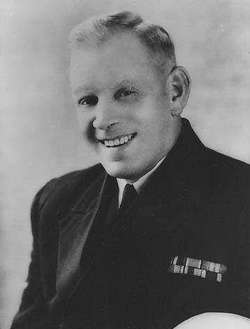- Author
- Turner, Mike
- Subjects
- Biographies and personal histories, WWII operations, History - WW2
- Tags
-
- RAN Ships
- None noted.
- Publication
- June 2010 edition of the Naval Historical Review (all rights reserved)
Lieutenant L.V. Goldsworthy, RANVR was initially rejected by the RAN (on the medical grounds of being too short) and became the most highly decorated officer in the history of the RAN. He became the acknowledged underwater mine disposal expert in the European Theatre, disposing of hundreds of mines or bombs in the UK and Europe.
Following the Allied invasion he was in a ‘Mine Recovery Flotilla’ operating in Europe and attached to Vernon. He was awarded the DSC for rendering safe the first German K-type (‘Katy’) snag-line mine during the liberation of Cherbourg whilst German snipers were still active. Goldsworthy had to swim through 90 m of giant weed in intensely cold water to get to the mine, and ‘the rumbles of distant underwater explosions did not add to comfort.’
Middle East
No details are known of the RMS operations by Lieutenant Ernest Ruttle, MBE, RANVR. He sailed to the UK with Leon Goldsworthy, and was with other ‘Yachties’ in HMS Euphrates for an extended period in the Persian Gulf.

Harry Fenemore was born in England in 1900. He joined the Royal Navy in 1916 and saw active service in HM Ships Ganges, Bacchante and Barham during World War I. He then transferred to the RAN in 1920, and saw active service in HMA Ships Stuart, Vendetta, and Napier in the Mediterranean in 1940-1942. As a forty year old Leading Seaman Standard Diver he was lent to the Royal Navy [Suez] Canal Mine Clearance Party from 28 March 1941 to 31 December 1941. The British had an accurate mine watching system along the Suez Canal, and conducted magnetic and acoustic sweeping near the mine watching datum, including magnetic sweeping by Wellington DWI aircraft fitted with a large electric coil. If a mine was not swept it was located and countermined by a diver in Standard Dress.
On one occasion, a German GD mine lay between three ships, and was too close for clearance by either sweeping or countermining. Fenemore had no way of knowing if the mine was an armed acoustic mine, in which case it would be detonated by his bubbles ((On 6 March 1941 Sub Lieutenant R.B. Sutherland, RNVR was killed in Falmouth Harbour whilst attempting RMS in Standard Dress on what was apparently an acoustic mine. A subsequent trial in the HMAS Vernon diving tank by Lieutenant Mould, RANVR and Lieutenant Syme, RANVR showed that the bubbles from a Standard Dress diving helmet would actuate a German acoustic unit.)). He showed great courage by diving in these circumstances. He located the mine using a circular search crawling on his hands and knees crabwise lest his helmet contact the mine in the zero visibility. Within 24 hours of the mine being laid he rendered it safe by removing the primer, cutting the detonator leads and removing the detonator. The bomb fuse was removed, and the mine raised.
Honours and awards
Lieutenant Ernest Ruttle, RANVR was awarded the MBE on 11 December 1945.
Leading Seaman Harry Fenemore, RAN was awarded the DSM in January 1942, the only RAN sailor known to have received an award for RMS during this war.
There were nine George Medals awarded to RAN personnel in World War II, and all were for RMS or diving. Lieutenant Commander Alan McNicoll, RAN was awarded the George Medal for ‘coolness and great courage in removing the inertia pistols from eight torpedoes of a captured Italian submarine.’ (He was to become Vice Admiral Sir Alan McNicoll, KBE, CB, GM, RAN, and First Naval Member and Chief of Naval Staff in 1968). Petty Officer John Humphries, RAN was awarded the George Medal for ‘skill and courage of the highest degree’ during twelve extremely hazardous dives to enter the flooded engine room of the German prize ship Hohenfels to shut bilge suction valves. He was without communications or a standby diver, and his descent included three long and two short ladders. ((Data from Commander E.W. (‘Jake’) Linton, BEM, RAN (ret).)). The other seven George Medals were awarded to RANVR officers for RMS tasks in the UK. ((The George Medal is awarded for ‘gallantry and undaunted devotion to duty’, whereas the George Cross is awarded for ‘great gallantry and undaunted devotion to duty’.)).
The achievements of RANVR officers in rendering safe bombs, bomb-mines and mines are almost beyond modern comprehension, and several officers were the most highly decorated Australian naval officers of the war. All of the four George Crosses awarded to the RAN during World War II were for RMS tasks in the UK and Europe. There is a display in the Australian War Memorial, Canberra commemorating their bravery and achievements.
Nine RANVR officers with awards for RMS in the European Theatre were (in alphabetical order):
- Lieutenant Geoffrey J. Cliff, OBE, MBE, GM*, BEM, RANVR (later Lieutenant Commander)
- Lieutenant Leon V. Goldsworthy, GC, DSC, GM, RANVR (also awarded a MID, and later acting Lieutenant Commander)
- Lieutenant George Gosse, GC, RANVR (later Lieutenant Commander)
- Lieutenant James H. Kessack, GM, RANVR (posthumous)
- Lieutenant John S. Mould, GC, GM, RANVR (also awarded a KCBC, and later acting Commander for an Admiralty appointment)
- Lieutenant Howard D. Reid, GM*, RANVR (later Lieutenant Commander)
- Lieutenant Ernest E. Ruttle, MBE, RANVR
- Lieutenant Hugh R. Syme, GC, GM*, RANVR
- Lieutenant Keith Upton, GM, RANVR




